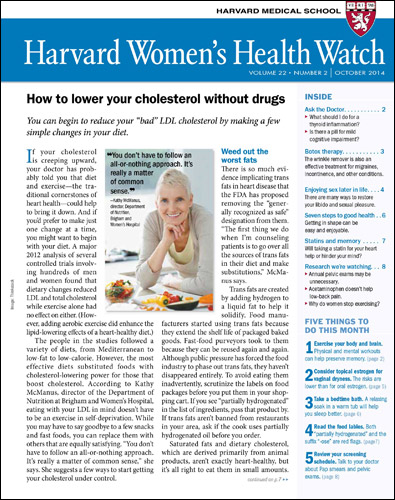Harvard Health Blog
Study supports alcohol, breast cancer link
For years, women have been cautioned that having more than one alcoholic drink a day increases the risk of developing breast cancer. A new study supports this link, and suggests that a drink a day may be too much (see “What is a drink?” below).
A team of Harvard-affiliated researchers tracked the health of 106,000 women over a 28-year period—an eternity in medical research. The women were asked several times over the course of the study about their diets, drinking habits, and much more. Women who had the equivalent of three to six drinks a week had a modest increase in their risk of breast cancer (15%) compared to women who never drank alcohol. While a 15% increase sounds like a lot, it would translate into an extra three cases of breast cancer per 1,000 women per year. The greater the alcohol consumption, the higher the risk of developing breast cancer. Two drinks a day would translate into an extra four cases of breast cancer per 1,000 women per year.
It didn’t matter what type of alcohol the women drank. The risks were the same for wine, beer, and spirits.
The results, published yesterday in JAMA, solidify what we know about the connection between alcohol and breast cancer. But how do they square with all of the “alcohol is good for your heart” messages women (and men) have been getting over the years?
The risks and benefits of alcohol have been calculated for large groups of women. But none of us is exactly like the mythical average woman that emerges from large studies. What’s important is to determine how alcohol consumption might affect us as individuals. As explained in an article in last month’s Harvard Heart Letter, “More to the story than alcohol = heart protection,” that depends on our own health risks.
If you are at high risk for coronary artery disease and low risk for breast cancer, a drink a day could be beneficial. If you are at high risk for breast cancer, then drinking alcohol might do you more harm than good. And keep in mind that alcohol affects almost every other system in the body beside the heart and breast.
With all the focus on the benefits and risks of moderate drinking, excess drinking is often overlooked. The National Institutes of Health estimates that 4 in 10 people who drink alcohol are heavy drinkers or at risk for becoming one, and that nearly 19 million Americans have a problem with alcohol.
If you are worried about your drinking, take one of the tests posted on our Web site, or check out Rethinking Drinking, a free report from the National Institute on Alcohol Abuse and Alcoholism.
What is “a drink”?
 In the United States, a standard drink contains about 0.6 fluid ounces of alcohol. The drinks shown above contain roughly that amount of alcohol. Moderate drinking is generally defined as no more than two drinks a day for men and no more than one drink a day for women. The National Institute on Alcohol Abuse and Alcoholism defines drinking as low risk, increased risk, and highest risk.
In the United States, a standard drink contains about 0.6 fluid ounces of alcohol. The drinks shown above contain roughly that amount of alcohol. Moderate drinking is generally defined as no more than two drinks a day for men and no more than one drink a day for women. The National Institute on Alcohol Abuse and Alcoholism defines drinking as low risk, increased risk, and highest risk.
About the Author

Carolyn Schatz, Former Editor, Harvard Women's Health Watch
Disclaimer:
As a service to our readers, Harvard Health Publishing provides access to our library of archived content. Please note the date of last review or update on all articles.
No content on this site, regardless of date, should ever be used as a substitute for direct medical advice from your doctor or other qualified clinician.
















